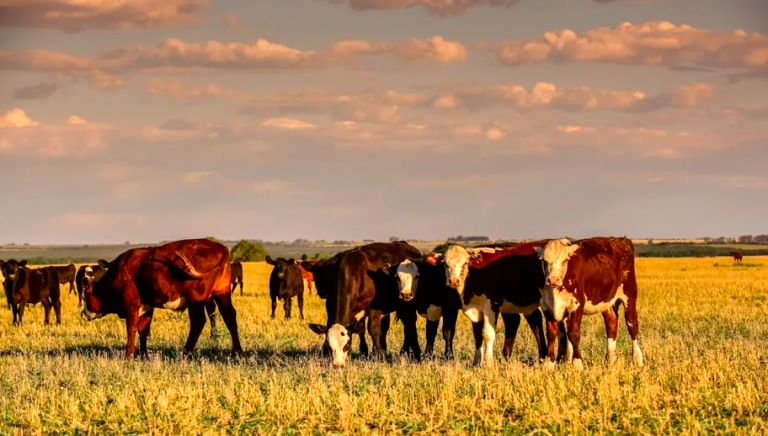Ernesto Viglizzo, La Nación (Argentina), June 25, 2022.
As scientific knowledge advances, the true role of cattle production in the emission of greenhouse gases can be elucidated in relation to other sectors of the economy.
As soon as the FAO published "The Long Shadow of Cattle" in 2006, the cows fell under a blanket of suspicion and criticism rained down on them. Among other calamities, attempts were made to show that the gases emitted by cattle were major factors in global warming and climate change. Its authors charged the emissions of other non-agricultural sectors, such as input manufacturers, transporters, refrigerators, retail distributors, vendors, etc., to the "carbon account" of cattle.
Although the calculation attributed 18% of global emissions to cows, a subsequent recalculation (2013) lowered that figure to a suggestive 14.5%. Only one step intervened between those figures and the beginning of an aggressive campaign to reduce the consumption of meats and dairy products.
Today we detect inconsistencies in those reports: if national inventories assign emissions to the industries that actually produce them, it is not lawful to assign them in parallel to livestock. It would be a case of duplicate accounting. When that duplication is omitted and only biogenic emissions from livestock (metabolic in origin) are computed, that figure drops to less than 5%. Furthermore, this percentage tends to decrease year after year because the consumption of fossil fuels increases. What lesson remains for us? That the calculation method determines the number, and that the number can mislead public opinion.
We know that the methane emitted by ruminants is a powerful greenhouse gas. Recent publications differ in their estimates, but cattle would emit between 17 and 24% of global emissions. The rest would come from other sources. In between, there are two things to clarify:
- While other greenhouse gases (such as carbon dioxide and nitrous oxide) can persist in the atmosphere for decades or even centuries, methane decays and loses its warming potential in about ten years. This means that the persistence of the gases is not comparable, and that a correction of the calculations is inevitable.
- Cattle synthesize the methane emitted from carbon that was already in the air, and that was previously captured through photosynthesis by the plants they consume. Livestock do not add more carbon to the atmosphere; it simply recycles the one that already existed. The opposite occurs in industries that burn fossil fuels: year after year they add new volumes of carbon to the atmosphere, without intermittence. The statistics prove it: in 1995 approximately 17% of global emissions came from the rural sector; in 2021 that figure dropped to less than 7.5%. Of the remaining 92.5%, almost 70% comes from industries that depend on fossil energy. Beware, then, of strategies that shift the focus from those industries to livestock!
The carbon footprint, which measures the emission per kg of product, is another notion to review. The method always produces an asymmetry that is repeated: a kilogram of beef can emit between 40 and 70 times more carbon than a kilogram of grain or other vegetable products. That contrast affects the reputation of cattle. But if instead of using the kg of product as a reference unit, we calculate the emissions per productive hectare, the divergence between bovine and vegetable products can be greatly altered. Again, the results vary depending on the method applied.
From a domestic perspective, it is pertinent to ask ourselves how much do Argentine cows emit and how much do they influence global warming? According to global statistics from 2019, Argentine cattle emit approximately 0.16% of global emissions. Being well below 1%, it is clear that its influence on global warming is insignificant. What practical sense would it make to lower the bovine population in a country that feeds itself and generates foreign exchange from it?
Emissions
What has been said so far tells part of the story: that of emissions. The other part forces us to look at the carbon captured on our extensive ranching lands. Our country has a gigantic photosynthesis platform capable of capturing and accumulating organic carbon in the biomass of vegetation and in the soil.
As we have few field measurements, for now we can only work on hypotheses. But we should not be surprised by a positive net balance if carbon sequestration and accumulation on rural land exceeds its emissions. There is a methodological challenge to explore.
In short, the long shadow of the cattle gets shorter every time science illuminates new things.As we learn, we realize that carbon inventory methods are not fully resolved and produce uncertainty. Although our country reports inventories adjusted to an internationally accepted methodology, these numbers do not necessarily reflect the reality of Argentine cattle farming. The real impact of methane on global warming and carbon sequestration in our grazing lands are two pending issues. As the debate continues, the farmer concerned about the emissions from his cows can be advised not to assume a priori blame for sins he has not committed..



